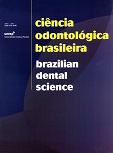Avaliação da resistência adesiva entre uma cerâmica aluminizada e um cimento resinoso submetidos à ciclagem térmica
DOI:
https://doi.org/10.14295/bds.2003.v6i3.601Abstract
O objetivo deste estudo foi avaliar o efeito da ciclagem térmica sobre a resistência adesiva entre a superfície cerâmica do In-Ceram (Vita Zahnfabrik, Bad Säckingen, Alemanha) e o cimento resinoso (Panavia F, Kuraray CO, Japão). Foram fabricados nove blocos cerâmicos com dimensões de 5x6x6mm. Uma das faces com 5x6mm de cada bloco cerâmico foi condicionada com uma cobertura triboquímica de sílica (Sistema Rocatec, ESPE - Seefeld - Alemanha) e em seguida cimentada com Panavia F a outro bloco idêntico de resina composta (Clearfil AP-X, Kuraray CO - Japão). Os nove grupos formados por cerâmica, cimento e resina composta foram cortados em 60 corpos-de-prova com dimensões de 10x1x1mm e área adesiva que apresentava 1mm2± 0,1mm2. Os corpos-de-prova foram divididos em 3 grupos (n=20): G1 - armazenagem durante 14 dias em água destilada a 37ºC; G2 - 6000 ciclos térmicos (5ºC - 55ºC, 30s em cada temperatura); G3 - 12000 ciclos térmicos (5ºC - 55ºC, 30s em cada temperatura). Após os condicionamento térmicos, os corpos-de-prova foram fixados com adesivo de cianoacrilato ao dispositivo de microtração e testados em uma máquina de ensaio universal (EMIC - DL-1000, Equipamentos e Sistemas Ltda., dos de São José Pinhais - o PR, Brasil) com velocidade constante de 0,5mm/ min. Os dados foram submetidos aos métodos estatísticos de ANOVA e Tukey . Os resultados indicaram que os valores médios de tensão de ruptura (MPa) de G1 (14.97±4.68) não diferiram estatisticamente (p <5%) de G2 (12.27±4.72), porém houve diferença significante entre G1 e G3 (9.89±4.16). Foi possível concluir que a termociclagem reduziu os valores de resistência adesiva significativamente quando os corpos-de-prova foram submetidos a 12000 ciclos.Downloads
Downloads
Published
How to Cite
Issue
Section
License
Brazilian Dental Science uses the Creative Commons (CC-BY 4.0) license, thus preserving the integrity of articles in an open access environment. The journal allows the author to retain publishing rights without restrictions.
=================




























